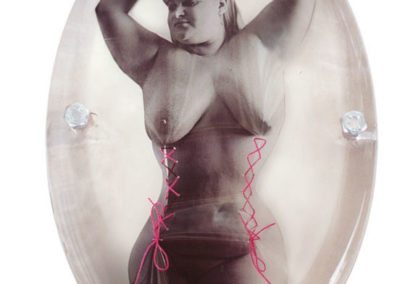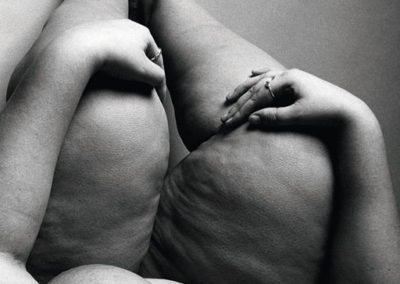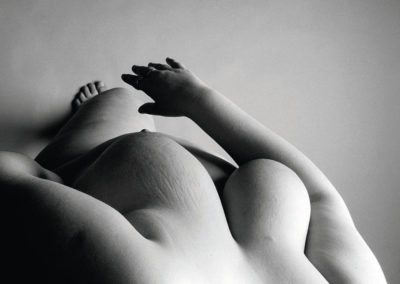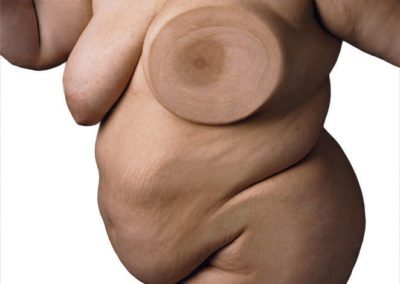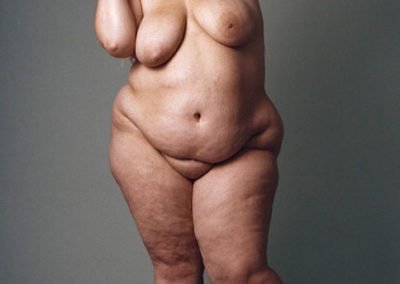Body Image Fitting
Personal and Dress Fitting – Against Society’s Prescribed Canon
The body, along with the individual’s relation to his/her own body, has undergone significant changes in the nineties, as Hungary began to change into a consumer society. The round ideal of the fifties was followed by the girlish physique of the sixties. By the eighties, the muscular female body became the etalon, which was, by the end of the century, replaced by the “double zero” physique, the so-called heroin chic. The collective social pressure dictates mandatory norms irrespective of one’s body type. Parts of the female body become selectable, changeable and sometimes replaceable, in response to constantly changing needs. The universal health cult prescribes a young and thin body for women, and this expectation becomes a standard for all ages.
Luca Gőbölyös has just passed thirty when she began her “obese women” series within the framework of the József Pécsi Art Photography Scholarship. According to her own account, the reason she became interested in obesity and its social contempt was that she also felt she had some weight to lose, and this troubled her. Critical feminist analysis has uncovered the underlying reasons for contemporary society’s fear of obesity, by showing that body image disorders and extreme weight control in women usually appears at times of transition, be it cultural change, transition between family and career roles, or moving from one age group or generation to the next. One of the series’ parts, entitled Personal, shows fragmented female bodies that differ from the consensual, ideal female body, and would be considered overweight or obese. According to social expectations, the female biological clock ticks faster passed the age of thirty: tissues loosen up, soft skin becomes wrinkled, and it becomes easier to put on (or lose) weight. Society expects women to keep their bodies in check, and to constantly observe and control themselves. In a subversive manner, Gőbölyös exploits and evades this objectifying approach, using the gesture of depriving her models of their individuality, photographing them as reduced to their bodies alone. Presenting an obese female body seems as an adequate metaphor for shedding light on the exclusion-based structures of power that are at work in society, as an obese body evokes aversion. Simply by choosing a perspective (as the viewer becomes the subject of the photo), a series of emotions based on repression are triggered. She faces her own fears, and also compels everyone else to do so, to experience what she does, that is, seeing herself as obese. The role of the outside observer, the voyeur, cannot be assumed here, and is replaced by a disturbing feeling of identification.
The body as a cultural metaphor is the main site of social control, and also a possible medium of communication for Gőbölyös. She presents the obese bodies against the collective pressure, also considering them self portraits. Who’s is the controlling gaze? Luca Gőbölyös’s? The viewer’s? Or is it the virtual gaze of the patriarchal control that is judging and scrutinizing the overweight female body, which is very distant from the norm. In some cases, Gőbölyös presents „her body” in accordance with the accepted rules of the modernist paradigm. Thus, the compact subject with closed thighs, posing as a nude, becomes an extreme symbol of the woman reduced to the domestic and reproductive role. In other cases, we can discover the unsure and insecure, human gestures of a naked woman observing herself. While the classic nude, with its ethereal perfection, presents the immaculate female body, the naked body is irregular, clumsy, changing, and is also hairy and fat, thus evoking disgust and aversion. The naked models of the series fit the category of the abject, according to both the social and artistic canons. They arouse emotions of fear and disgust and are examples of the grotesque female body. By showing one of her female subjects in a bathtub, cleaning herself, she directs our attention to another social theme. Hygiene is yet another symbol of social control, maintaining order against the subversiveness of dirt, irregularity, distortion, or in other words, that which is outside of the norm. The bathtub appears as a vessel of social expectations, within which the obese body cleans itself with soap, showing submissionto the norm.
In the other part of the series, entitled Dress Fitting, the female body appears changed in accordance with social expectations. The waist encircled by a tight pink ribbon, the laces in the detail remind us of a „garment”. The model’s unnatural grace, her imitation of the classic desire evoking pose and the airy bow of the pink ribbon symbolize the subtle, often unconsciously followed terror of the dominant social norm. This is what makes Gőbölyös’s gesture truly subversive, since she instantly draws a parallel between the age-old dress codes and body trends of the patriarchal mentality, and the workings of the contemporary media and beauty industry.
Kata Oltai
Commissioned text

